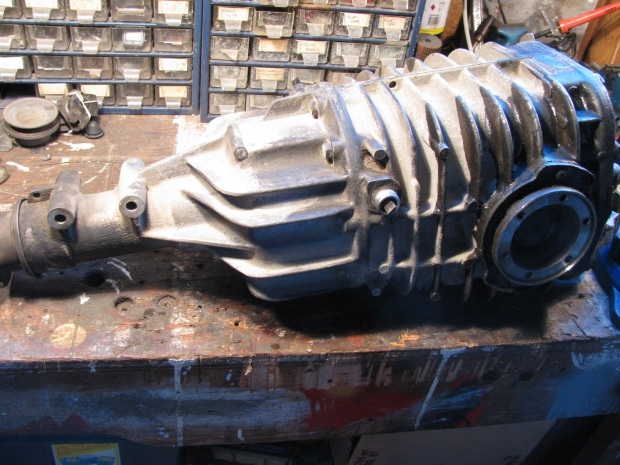I pulled the front diff. on the syncro today to replace the old failed (weak) viscous coupling (vc) with a good used one. Dropping the diff. is in the Bentley manual so I won’t describe that part except to say that it takes a bit of wiggling to get it out. I used a motorcycle lift as a transmission jack. Once out I set it on a container to drain.
See the dark dirt on the input end? Looks like the oil seal there is leaking, need to attend to that. Once most of the oil drained out I humped it onto the bench, just to look at it.
See the speedo drive sticking out? Then it’s on to the floor and off with the 13mm bolts holding the skinny end on.
Some tapping with soft faced hammer to break the seal and it comes apart.
Yup, that’s the vc sitting there, with a spacer on top.
The vc just lifts right off, exposing the speedo drive gear on the pinion shaft.
Closer view of speedo gear.
With the case separated I drained the remaining oil, applied some sealant to the mating surfaces, put the new vc on the pinion (and didn’t forget the spacer) and the skinny part of the case re-installed and torqued down. All well and good, refill with oil in the morning. Now the interesting bit. I had to take the end plate off the old vc, I was dying to see the inside first hand. The big C-clip came out easily.
That end plate should then pull out, but it wouldn’t come. I thought maybe if I drained the vc and also run an awl around the edge of the plate to remove gunk it might help matters. The silicone flowed out, not as viscous as I have seen in those German videos showing refills, and looking like it might have some gear oil in it. BTW, didn’t smell bad.
Got the end plate off.
Removed the C-clip on the shaft (barely visible in above pic) and pulled the first two plates out to look at the adjacent surfaces. Need any more evidence that the plates do come in contact during hump? Upper plate in pic has been flipped over.
Close ups.
Accepted wisdom is that a weak vc is due to the silicone fluid leaking out. One could expect an O-ring to fail with time, but what I found was something else. I had a look at the X-ring that seals around the central shaft (there are two, one on each end, the one shown is in the end plate). It appears that the X-ring is twisted in the groove, look.
Out it comes, yes, it is twisted.
Another view (damned cat hairs, get everywhere).
This surely must have happened at the factory, a lip of the X-ring getting caught on the shaft during assembly. Tsk, tsk, Steyr-Puch.
Addendum: I’m assuming the vc had leaked some fluid, but even with that folded X-ring I have no proof. The “dirty” fluid from the vc could be gear oil contaminated or it could be metal particles from the plates. Perhaps I can use a magnet to determine?
















#1 by alika on October 23, 2011 - 9:40 pm
Having fun? Nice pictures,we don’t see much details like that very often 🙂
Alika
#2 by albell on October 23, 2011 - 10:46 pm
I am having fun 🙂
I’ll be taking more pics when I take the vc apart proper.
cheers
ab
#3 by IdahoDoug on October 23, 2011 - 11:50 pm
good idea with the magnet – let me know what you find. Doug
#4 by albell on October 24, 2011 - 7:08 am
Will do Doug.
ab
#5 by Robert on October 24, 2011 - 3:43 am
Nice job to document so nicely in your photos. Thank you for the good descriptions with the photos too. As a new’ish Syncro owner it helps a lot to understand these mechanics at the heart of the Syncro. Cheers!
#6 by albell on October 24, 2011 - 7:10 am
Thanks Robert,
I’ll take more pics as I disassemble the vc further. I need to make a simple rack/post to keep the plates in the same order as they are in the housing.
ab
#7 by Adam Wade on August 26, 2012 - 4:44 pm
Excellent analysis! I hope this can be of use to me when I become the first (?) to tear down a weak VC from a BMW 325iX to see if I can rebuild it to reasonable standards and a decent lifespan. I am gathering all the information I can get to keep me from reinventing the wheel as much as possible with this VC, which locks up much more quickly than most street car VCs (used only in the transfer case/center diff) and nearly always fail by slipping rather than becoming more aggressive in locking. If you can provide any further insight, it would be incredibly welcome!
#8 by albell on August 26, 2012 - 4:58 pm
Hi Adam,
I’m a bit stalled on my rebuild as my source of silicone fluid is a bit slow on delivery 🙂 One concern I have on my unit is the amount of wear on the plates. I might go into it more in a blog post, but it seems that the small raised portion around the punched holes and slots are integral to the mechanism of the plates coming together in the humps state. Finding new plates is I think close to impossible, so I will just go ahead with what I have. Let me know if you have any questions, this is just a quick reply.
cheers
alistair